Africa’s lion population is falling
Africa’s lion population is falling
An interview with lion researcher Leela Hazzah
mongabay.com
March 25, 2008
|
|
The lion is Africa’s best known carnivore. Once widely abundant across the continent, recent surveys show that lion populations have plunged from over 100,000 individuals to around 23,000 over the past century. The reason for recent declines? Lions are poisoned, shot, and speared by locals who see them as a threat to livestock. While lion populations in protected areas remain relatively healthy, conservationists say that without urgent measures, lions may disappear completely from unprotected areas.
The Kilimanjaro Lion Conservation Project is working to avoid this fate by developing practical measures to encourage coexistence between people, livestock and predators. Key to the effort is reducing livestock losses to lions.
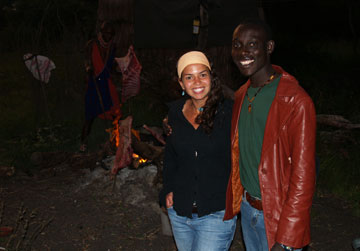 Director and Assistant Director of Lion Guardians (Leela Hazzah and Antony Kasanga) at a goat roast 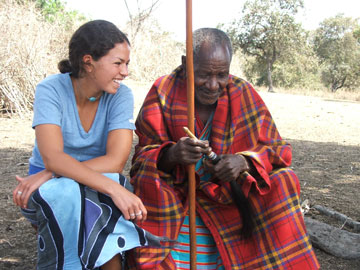 Leela Hazzah and Baba Murua |
Leela Hazzah, a field researcher with the project, says the “Lion Guardians” program at Mbirikani Ranch in Kenya has proved remarkably successful: not a single lion has been killed since its inception in November 2006. The program employs Maasai warriors, known as murrans, to monitor lions and help local communities prevent attacks on livestock.
“Lion Guardians aid their communities by informing herders to avoid grazing areas where lions are present, improving livestock bomas (corrals), helping herders find lost livestock in the bush before they are killed by predators, educating their communities about carnivore conservation, and, most importantly, working with other murrans to prevent lion killings,” explained Hazzah.
“We are currently working to expand the successful Lion Guardian program onto a neighboring group ranch, Olgulului, where over 65% of all lion killing in the Amboseli-Tsavo Ecosystem since 2004 has taken place.”
In a March 2008 interview with mongabay.com, Hazzah talked about lion conservation efforts in Kenya.
Interview with Leela Hazzah
Mongabay: What is the Kilimanjaro Lion Conservation Project?
Leela Hazzah: Kilimanjaro Lion Conservation Project (KLCP) is part of a non-government organization called ‘Living with Lions’ (www.lionconservation.org) which has two projects; one in Laikipia (northern Kenya) called the Laikipia Predator Project and one, KLCP, in southern Kenyan Maasailand. My work is focused in Kenyan Maasailand with KLCP.
Mongabay: How did you become interested in wildlife and specifically lion conservation?
|
Olubi tracking lions. Photo by Seamus Maclennan |
Leela Hazzah: Since I was young I have always had a desire to be outdoors, with wildlife, whether at the National Zoo in Washington D.C. or watching camels in the desert during my summer breaks in Egypt. As a young girl, I would listen to my father’s tales of all the wildlife that roamed the deserts of Egypt. It frustrated me that the wildlife he knew as a young boy no longer existed in Egypt. I couldn’t go to the deserts and hear lions roar as he did or see wolf tracks around our family’s desert home. This led me to pursue a degree in Biology and focus my studies on wildlife conservation. I specifically chose lion conservation because lions are rapidly declining due to conflict with people, but also because they are a symbol of wildness.
Mongabay: What is your academic background?
Leela Hazzah: I have a Bachelor’s degree in Biology from Denison University in Ohio, a small liberal arts University. Last year I completed my MSc in Conservation Biology and Sustainable Development at the University of Wisconsin-Madison. My thesis was entitled: Living Among Lions (Panthera leo): Community attitudes towards conservation initiatives and the motivations behind lion killing in Kenyan Maasailand.
Currently, I am working toward my PhD at the University of Wisconsin-Madison continuing my work on Maasai-carnivore conflict in southern Kenya and directing a community conservation initiative called, “Lion Guardians”.
Mongabay: What is your normal day like? Is most of your time spent working with local people or lions?
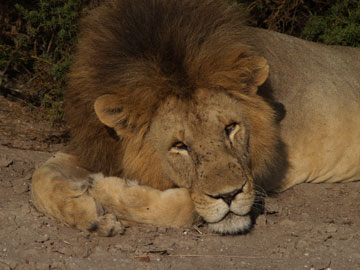 Lion. Photo by Seamus 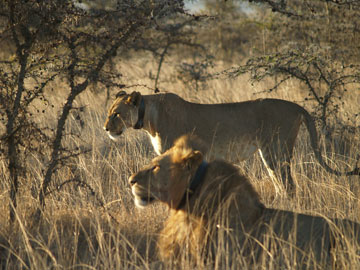 Sangale and Nemesi. Photo by Seamus |
Leela Hazzah: There is really no “normal” day in the bush. What becomes ‘normal’ to us is rushing off to check on a livestock carcass that a lion has killed during the night, attempting to assuage angry livestock owners from retaliating on a carnivore that has just killed their favorite cow. I also spend a lot of time just talking to the murrans (Maasai warriors) as they are the ones mainly responsible for lion spearing. Most of my time is spent directing the Lion Guardian program (see below) with Antony Kasanga (assistant director); it takes up a lot of time, but it is truly enjoyable and rewarding work. Antony and I spend a lot of our time with the Guardians helping them solve problems they may encounter with the communities or the lions. We assist them in reinforcing bomas (thornbush corrals) to keep carnivores out. We hold meetings in the communities to discuss the Lion Guardians program and any advancement or changes in the program. These meetings are important as they provide a platform where communities can offer suggestions to improve the program.
Mongabay: Why are lions threatened? Is poaching for the wildlife trade or illicit trophy hunting an issue there?
Leela Hazzah: Lions are declining throughout their range. East Africa is one of their last strongholds, containing approximately half of the remaining African lion population (the majority is in Tanzania). In Kenyan Maasailand, Maasai people are spearing and poisoning lions at a rate that will ensure local extinction within a decade. Lion killing is embedded within Maasai perception of depredation by lions on livestock, socio-economic factors, and the complex relationship between Maasai and conservation. These all affect tolerance for lions and consequently Maasai behavior towards conservation initiatives and carnivores in general.
Trophy hunting was banned in Kenya in 1978 so it does not contribute to the declining lion populations, though many believe managed trophy hunting may be beneficial to carnivore, in particular lion, populations. Illegal wildlife poaching does impact lion populations, though minimally. The most significant reason for lion decline is retaliatory (Olkiyoi) and ritual-based (Olamayio) lion killing by Maasai. Also, retaliatory poisoning in response to livestock depredation has a huge effect on carnivore populations and may kill off whole prides of lions.
Mongabay: What’s the best way to minimize the impact of lions on livestock? How do you encourage local people to not take up arms against opportunistic predators? Are they compensated for losses?
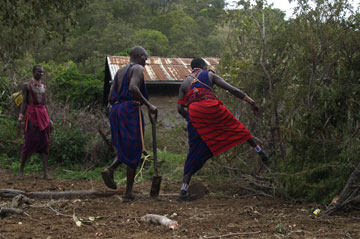 Lion Guardians fixing a livestock kraal (boma). Photo by Seamus Maclennan |
Leela Hazzah: The best way to minimize livestock losses to lions is to encourage vigilance while herding so no livestock is lost in the bush and also by promoting strong, well-built bomas (corrals) to keep livestock in at night helps reduce depredation rates. In response to high levels of killings in this ecosystem, and in partnership with communities of Mbirikani Group Ranch (MGR) and Maasailand Preservation Trust (an NGO), we initiated a hugely successful community conservation program called Lion Guardians. The project includes four components:
- Highly participatory and capacity building; allowing Maasai to aid in the creation and running of the project
- Culturally and socially acceptable amongst the Maasai
- Ensure that communities are receiving benefits from the wildlife on their land
- Produce tangible results, conservation confirmed through science
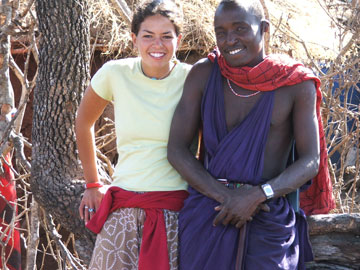 Leela Hazzah and Lepencha. Photo by Jacob Mayiani 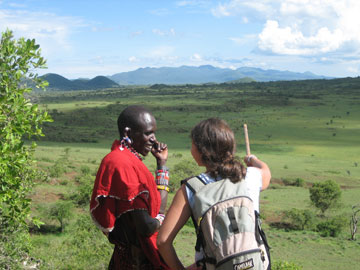 Leela Hazzah and Kapande (Lion Guardian) tracking lions. Photo by Antony Kasanga |
The Lion Guardians are murrans employed to monitor lions, collared and uncollared (in conjunction with our researcher), and to assist their respective communities in preventing carnivore attacks on people’s livestock. Because Guardians come from the areas where they work and are more experienced murrans (many have killed lions), they are well respected by their communities and can dissuade angry warriors seeking revenge for their dead cow. Currently, nine Lion Guardians cover core human-lion conflict areas on Mbirikani Ranch where KLCP is based.
Lion Guardians have two major duties which benefit both the lions and the communities: 1) monitor lions movements by radio telemetry and traditional tracking techniques; and 2) aid their communities by informing herders to avoid grazing areas where lions are present, improving livestock bomas (corrals), helping herders find lost livestock in the bush before they are killed by predators, educating their communities about carnivore conservation, and, most importantly, working with other murrans to prevent lion killings. Since the inception of Lion Guardians in November 2006, no lions have been speared in Mbirikani Ranch, this is the longest respite since the late 1990s; though, on neighboring group ranches lions continue to be slaughtered. We are currently working to expand the successful Lion Guardian program onto a neighboring group ranch, Olgulului, where over 65% of all lion killing in the Amboseli-Tsavo Ecosystem since 2004 has taken place (i.e., over 60 lions).
For more information on the Lion Guardian program, visit the murran-ran blog site at lionguardians.wildlifedirect.org. The blog is an interactive platform where the Lion Guardians can narrate their daily stories, adventures, accomplishments, and news to interested readers and conservationists. The Lion Guardian blog also helps with fund raising–we get an amazing amount of support from donors all around the world.
Mongabay: Why lions are worth saving if they only endanger wildlife and livestock? Can you explain why we should take special efforts to protect predators?
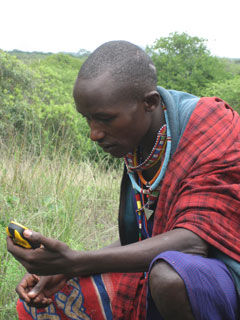 Retei (Lion Guardian) taking GPS point. Photo by Leela Hazzah |
Leela Hazzah: Many Maasai would say that lions are not worth saving because they kill livestock and do not bring any benefits back to the people. However, this view is slowly changing as Maasai are increasingly engaging in lion conservation activities. They are starting to realize that lions have value, both ecologically and culturally. Lions are top predators in the ecosystem and play an important role in maintaining equilibrium. Also, to the Maasai, lions are symbols of strength and courage. Traditionally, Maasai held a deep respect for lions, but due to many factors including an increase in conflict between livestock and carnivores, lions are not valued and respected as they once were. In the end, the brunt of living with carnivores cannot fall solely on the shoulders of Maasai; they must begin to see some tangible benefits (both economic and not economic) from coexisting with wildlife if conservation is to succeed.
Mongabay: Do you have any notable close-calls working with big cats?
Leela Hazzah: With the big cats we work under the belief “If you don’t bother them, they don’t bother you”. We make smart decisions such as not walking around in the bush alone at night. The animals I worry about most are the African Buffalos and Elephants. If you aren’t paying attention and walk up on them you may find yourself in a very bad situation.
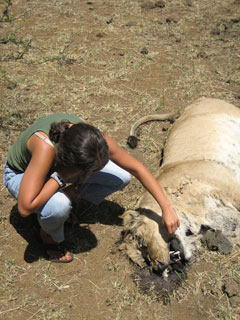 Hazzah examining dead lion. Photo by Seamus Maclennan 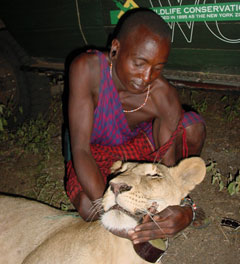 Lepencha collaring lioness. Photo by Seamus Maclennan |
Mongabay: Do you have any advice for students who are interested in pursing wildlife conservation fieldwork?
Leela Hazzah: Experience is the name of the game. If students are interested in pursing a career in conservation then I would strongly suggest volunteering in any project that is of interest to you. I cannot stress enough how important getting experience in the field doing hands-on conservation of any wildlife species will improve your chances immensely in pursuing your dreams. Find a place, species, or people that interest you and go for it. Once you have some experience under you belt and have a better idea of what exactly you want to specialize in then apply to Graduate school in Conservation Biology, Environmental Studies, or any Wildlife Ecology related programs.
Mongabay: How can people at home help protect big cats and other endangered carnivores?
Leela Hazzah: People can help by staying educated on conservation issues, making smart decisions in their everyday lives about their use of resources, also by voting in policy-makers that are conservation oriented. A direct way to help protect big cats and other endangered carnivores is by donating to conservation organizations that are doing frontline work involving local communities such as Living with Lions and the Lion Guardian program.
Further reading